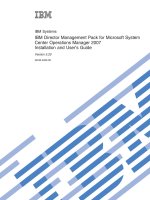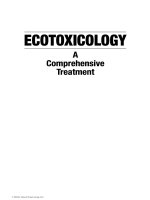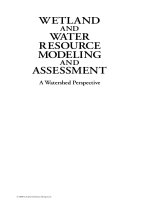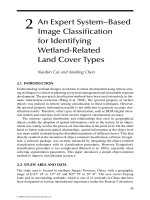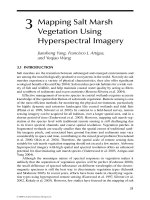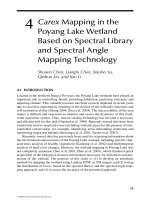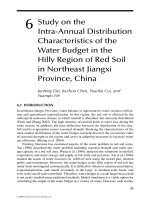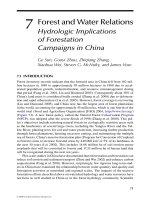WETLAND AND WATER RESOURCE MODELING AND ASSESSMENT: A Watershed Perspective - Chapter 20 pptx
Bạn đang xem bản rút gọn của tài liệu. Xem và tải ngay bản đầy đủ của tài liệu tại đây (342.57 KB, 12 trang )
247
20
Integrated Modeling
of the Muskegon River
Tools for Ecological Risk
Assessment in a Great
Lakes Watershed
Michael J. Wiley, Bryan C. Pijanowski,
R. Jan Stevenson , Paul Seelbach,
Paul Richards, Catherine M. Riseng,
David W. Hyndman, and John K. Koches
20.1 INTRODUCTION
The rapid pace and pervasiveness of landscape modication has made predicting
watershed vulnerability to landscape change a key challenge for the twenty-rst cen-
tury. River ecosystems are, in particular, directly dependent on landscape structure
and composition for their characteristic water and material budgets. Although it is
widely acknowledged that landscape change poses serious risks to river ecosystems,
quantication of past effects and future risks is problematic. Important issues of
scale, hierarchy, and public investment intervene to complicate both assessment of
current condition and the prediction of riverine responses to changes in landscape
structure. In this paper we demonstrate how neural-net approaches to landscape
change prediction can be coupled with river valley segment classication to provide
a framework for integrated modeling and risk assessment across large-scale river
ecosystems. Specically we report on progress and techniques being employed in a
collaborative risk assessment for the Muskegon River watershed, a large and valu-
able tributary of Lake Michigan.
Both watershed-based modeling and river classication have been proposed as
methods of simplifying analysis in order to more efciently protect river ecosystems
(Hawkes 1975, Hudson et al. 1992, Maxwell et al. 1995, Wiley et al. 1997). Linking
typical status and risk assessment models (e.g., bio-assessment protocols or predic-
tive models, see Wiley et al. 2002) to explicit classication systems (Seelbach and
Wiley 2005), however, remains a key methodological challenge. Ideally, a solution
would provide both a spatially explicit classication system that simplies the natu-
ral complexity of our rivers, and a method for coordinating suites of physical and bio-
logical models capable of predicting ecological status across a region and over time.
© 2008 by Taylor & Francis Group, LLC
248 Wetland and Water Resource Modeling and Assessment
As a part of a large collaborative study (Stevenson et al. this volume) of the
2,600-square-mile Muskegon River watershed, we have recently developed a GIS-
based approach using ecologically dened valley segment units (Seelbach et al.
1997, Seelbach and Wiley 2005, Seelbach et al. 2006) to integrate a state-of-the-art
neural-net model (Landscape Transformation Model: LTM, Pijanowski 2000, 2002)
with a variety of hydrologic and other models for the purpose of conducting rigorous
integrated risk assessments at a watershed scale. The result is a modeling system,
the Muskegon River Ecological Modeling System (MREMS), in which a variety
of models can be used together to estimate risks to key watershed resources arising
from various landscape change scenarios. Valley segment–scale ecological classi-
cation units (VSEC units; Seelbach and Wiley 2005) are used as an efcient and
ecologically meaningful physical framework for organizing data exchanges among
interacting models and stratifying model predictions. Output is remapped onto clas-
sication units to summarize and visually integrate spatially explicit forecasts of
ecological status and future risk.
In this paper we provide a basic description of the structure of the MREMS
system and detail the model linkage strategy we are employing. In addition, we pro-
vide preliminary examples of integrated assessment modeling based on the coupled
execution of a series of land use change, hydrologic, loading, and biological response
models from our Muskegon River studies.
20.1.1 METHODOLOGY
MREMS is a distributed modeling environment in which we are linking many dif-
ferent kinds of models to build a comprehensive picture of how the Muskegon River
ecosystem functions (Figure 20.1). In many cases we are using several models of the
same general phenomenon because often they employ different approaches, scales,
or generate different types of useful output. Philosophically our approach is to rec-
ognize the inherent inaccuracies associated with all modeling and to favor redun-
dancy by including many types of models, and modeling at multiple spatial scales.
Muskegon River Ecological Modeling System (MREMS)
Land Transformation
Model
Cultural Models
and Data
Social Drivers
Economic Valuation
Models
Ecological Services
Hydrologic and Chemistry
Models
Physical River Environment
Biological Models
River/Watershed Biology
Land use/cover
FIGURE 20.1 Schematic representation of the structure of MREMS components and typi-
cal execution order.
© 2008 by Taylor & Francis Group, LLC
Integrated Modeling of the Muskegon River 249
Therefore, MREMS can be best visualized as consisting of a suite of interacting sets
of models, each focused on a particular aspect of the Muskegon River watershed
environment. Integration occurs implicitly by requiring all models to either produce
valley segment–scaled output or output at a higher hierarchical scale that can be used
to drive ner-scaled models. Models that operate at reach or ner scales are required
to aggregate output to produce generalizations for the valley segment in which they
occur. MREMS system scaling adapts the classic hierarchy proposed by Frissell et
al. (1986) and recognizes the following potential scales for model execution: basin,
sub-basin, valley segment, reach (sub-vsec unit), channel habitat unit, cross-section.
Apart from its component models (see below) MREMS is essentially an explicit
protocol and directory structure (Figure 20.2) that facilitates the linked execution
of component models in a spatially explicit manner. MRI-VSEC version 1.1, a GIS
(geographic information system) product, provides the spatial framework for refer-
encing all input, output, and display of the component models in MREMS. Mod-
els communicate by placing appropriate identiable output (*.txt or *.dbf) into a
structured directory system that is organized into specic time frame (land cover
sample year), problem context (scenario), and management option (sub-scenario)
levels. At every level an INVAR (invariant) directory holds datasets, which are true
for that and all lower levels of the directory space, as well as a subdirectory index,
log, and other ancillary les (Figure 20.2). An MREMS run for a specic scenario
involves the serial execution of a set of component models for each time frame, using
scenario-specic, and sub-scenario-specic inputs and outputs. In many cases the
output written by one model may be used as input by the next. Execution order is
MREMS
TREE
Regulation
Regulation
Regulation
n
n
B
A
C
Year directories
Scenario directories
Sub-Scenario
directories
Climate
change
Slow
growth
Fast
growth
1830
1978
1998
2030
2040
INVAR
INVAR
INVAR
FIGURE 20.2 MREMS directory structure used to coordinate model input and output.
© 2008 by Taylor & Francis Group, LLC
250 Wetland and Water Resource Modeling and Assessment
determined by data dependency. Typically, execution order starts with the generation
of a land cover map (produced by LTM), followed by hydrologic, chemical loading,
and ecological and biological models in that order (Figure 20.1).
20.1.2 MREMS COMPONENT MODELS
We have developed MREMS as an open system in which any type of model can
in theory be used. At the present time we are working with suites of hydrologic,
loading, and biological models (Table 20.2). These models represent much of the
range in types of models used in natural resource planning contexts around the
world. Some are simple GIS models, some linear statistical models that produce
point estimates, and some are complex covariance structure models that describe
both physical and biological processes. Several are large-scale dynamic simulation
models (e.g., Hec-HMS, MODFLOW, several sheries bioenergetic growth models).
Beyond the neural net LTM, the most complex component models are the hydrologic
simulations implemented using HEC-HMS, GWLF, and MODFLOW. A basinwide
15-minute time-step version of the HEC-HMS is now being rened. In MREMS it
TABLE 20.1
Component models linked in MREMS.
Model Predicts Type
MODFLOW Groundwater ow Sim
MRI_DARY Groundwater inputs GIS
HEC-HMS Surface water ows Sim
MRI_FDUR Surface water ow frequencies Linear
HEC-RAS Surface water hydraulics Sim
GWLF Surface dissolved loads Sim
MRI_LOADS Surface dissolved loads Regress
MRI_JTEMP July water temp Regress
Assessment Models
All taxa
Sensitive taxa
EPT index
Algal index
Fish/insect diversity
Fish/insect diversity
EPT taxa
Algal status
Regress
Regress
Regress
Regress
Bioenergetic IBM
Steelhead
Salmon
Walleye
Growth rate and survivorship Sim
Sim
Sim
Biomass Composition
Sport shes
Total shes
Sensitive shes
Total algae
Filter-feeders
Grazing inverts
Kg/ha total mass
Kg/ha total mass
Kg/ha total mass
g/m
2
g/m
2
g/m
2
SEM, Regress
SEM
SEM
SEM
SEM
SEM
© 2008 by Taylor & Francis Group, LLC
Integrated Modeling of the Muskegon River 251
uses a two-layer custom groundwater recharge routine to generate baseow com-
ponents, which are then added to and routed through the HEC-HMS surface water
network. A scenario execution (see below) results in 20-year hydrographs being esti-
mated for each of 56 model elements. These in turn are used to interpolate 20-year
hydrographs for each of the 138 VSEC units in the Muskegon. HEC-HMS uses the
SCS unit hydrograph approach to interpret LTM-projected land cover changes and
produce resulting hydrographic predictions for the river system. The hydrographic
projections are then used to drive a variety of other component models in MREMS.
The most critical model for running risk assessment scenarios in MREMS is the
Land Transformation Model (Pijanowski et al. 2002), which provides us with chang-
ing land use distributions upon which many other component models react. LTM ver-
sion 3 is a data-intensive neural net model that predicts land use change at the level of
30-m pixels across the landscape. Neural-net “imagined” landscapes, coupled with a
standard 20-year climate scenario (1970–1990 observed temperatures and precipita-
tion), and best available DEM and geology covers provide the physical template from
which input parameters for constituent models are prepared. The Muskegon River
drainage net itself (in the form of the VSEC framework) is then used to identify
appropriate spatial strata for model parameterization and execution.
20.1.3 THE MRI-VSEC FRAMEWORK
For our model of the Muskegon watershed we have adapted the Michigan Rivers
Inventory VSEC version 1.1 system (Seelbach et al. 1999, Seelbach and Wiley 2005)
by correcting some minor mapping errors and transferring it to a 1:24000 scale
channel cover based on 1978 (MDNR, MIRIS) air photos. We dene ecological
valley segments (VSEC units) as (variably) large sections of river channel that con-
tain distinct, relatively homogeneous habitat conditions and biological assemblages.
Higgins et al. (1999) referred to units of this type and scale as sh macrohabitats.
TABLE 20.2
Example of future risk analysis by MREMS run for a fast-
growth scenario. Multiple ecological responses predicted
for 1998 to 2040 time frame comparison.
Site
%
DQ
a
Channel
b
Response
%
SL
c
%
TDS
d
Fish spp.
loss
Cedar Creek –13% aggrade +26% +32% 3–4
Brooks Creek –22% aggrade +72% +20% 1–2
Main River @ Evart 0% No change +1% +20% 2–3
Main River @ Reedsburg 0% No change +6% +3% 0–1
a
%DQ: percent change in dominant discharge (determines the size of the equilib-
rium channel).
b
Channel response: expected response based on %DQ.
c
%SL: percent increase in average daily sediment load (tons/day).
d
%TDS: percent change in median total dissolved solids concentration (ppm).
© 2008 by Taylor & Francis Group, LLC
252 Wetland and Water Resource Modeling and Assessment
Ecological valley segments combine elements of local valley and channel geomor-
phology with catchment hydrology, the two dominant forces shaping riverine habitat.
In general, this approach is conceptually similar to the hydrogeomorphic (HGM)
concept used in wetland assessment (Hauer and Smith 1998). The system identies
138 distinct (contiguous) channel units in the Muskegon River ranging from rst- to
fth-order channel segments (Figure 20.3). Major reservoirs and Muskegon, Hough-
ton, Cadillac, and Higgins lakes are included as separate VSEC units. In MREMS,
all models are required to provide model output referenced to one or more of the
138 segments. The resolution of the input and the scale at which the model executes
(e.g., a single site, multiple sites in the segment, the entire watershed) is left to the
individual model and modeler. Basic parameters for many landscape features (e.g.,
watershed land cover, surcial geology, elevation, basin size) are provided by the
MREMS system for upper, mid-point, and lower nodes of each VSEC unit.
To illustrate the general MREMS methodology, Figure 20.4 shows data
paths through MREMS used in a relatively simple coupling of 3 models (LTM,
MRI_FDUR, and MRI_LOADS) used in proof-of-concept tests in 2002. LTM is
the neural-net based landscape transformation model. MRI_FDUR, a hydraulic
geometry-based model from the Michigan Rivers Inventory Program (Seelbach and
Wiley 1997), predicts long-term ow duration curves for sites given landscape and
climatic inputs. MRI_LOADS is an empirical nutrient-loading model that predicts
instantaneous nutrient loads given land cover, geology, and catchment water yield.
Sample sites are used to represent the entire VSEC unit in which they occur, based on
the mapping criteria of ecological homogeneity, (Panel A, Figure 20.4). The VSEC
unit ID number is used to geo-reference and query associated catchment, riparian
buffer, and site scale databases to generate input parameters for component models
(Panel B, Figure 20.4). Once output is generated by the MREMS component models,
they are linked back to the VSEC unit ID and onto the VSEC spatial framework to
produce channel maps with explicit model predictions for each of 138 VSEC chan-
nel segments. Panel C of Figure 20.4 shows the Muskegon VSEC unit map with
! ##
$
& $
!"
# !$
! $
%
$
FIGURE 20.3 Watershed VSEC map providing the spatial framework for MREMS model
linkage. Based on VSEC version 1.1 (Seelbach et al. 1997), all model output requires explicit
referencing to one or more units.
© 2008 by Taylor & Francis Group, LLC
Integrated Modeling of the Muskegon River 253
predicted phosphate loading over time. The illustrated 2040 scenario gives expected
loads at the 10% annual exceedence discharge if high rates of urbanization observed
in the 1990s were to continue to the year 2040.
20.2 PRELIMINARY RESULTS FOR A RAPID
DEVELOPMENT SCENARIO
Full implementation and parameterization of the MREMS modeling system is not
scheduled to be complete until late 2007, awaiting the completion of eld studies
across the Muskegon basin. Nevertheless a number of preliminary runs have already
"1/1-*
$1+/
#1-0
$1+/
( !
!+71.
#0*16+2+
415*+
56+014+
+-/2,141
#&$2+-*4-10
(
!+71.
#12
4)+35+-+
A.
B.
C.
2/+-4+
( 50-4
'0-4*,00+/)58+
'0-4*4*,+04
%5425422-0
FIGURE 20.4 Illustration of model linkage in a simplied MREMS run. (See color insert
after p. 162.) See text for detailed explanation. Panel A illustrates the representation of a
sample site location by the mapped VSEC unit in which it occurs. Database information for
the unit’s upstream catchment, local riparian buffer, and other attributes are linked to the
site via the VSEC unit ID (Panel B). Panel C illustrates information ow and nal model
output mapping on the VSEC units for a simple run linking land cover data, MRI-FDUR (a
hydrologic model), and MRI-LOADS (an empirical nutrient-loading model) to predict daily
phosphate loads at ood ows (Q
10
= 10% annual exceedence discharge for the VSEC unit).
© 2008 by Taylor & Francis Group, LLC
254 Wetland and Water Resource Modeling and Assessment
been made, both to calibrate and evaluate component models and to rene linkage
protocols. These early runs use LTM projections assuming a 1990s rate of growth
and therefore provide a kind of “worst likely case” development scenario for the
basin. These runs are already proving useful in focusing current conservation and
restoration activities. The spatially explicit nature of the MREMS system identies
those segments of the rivers that are most at risk from rapid development and likely
patterns of land use change.
Regional LTM projections for the year 2040 using a fast growth scenario sug-
gest that most of the additional urbanization in the basin will occur along the Lake
Michigan–U.S. 131 corridor, and secondarily along other major transportation cor-
ridors across the Muskegon watershed (Figure 20.5). LTM-coupled HEC-HMS and
GWLF runs provide a basis for examining both direct hydrologic responses and
indirect hydrologic effects by driving other model impacts on water quality, sedi-
ment transport, potential channel geometry, and ultimately the response of biologi-
cal communities. For example, HEC-HMS output for Cedar Creek (a key lower river
tributary) showed a small but important hydrologic response to the 1998 versus 2040
landscape conguration using identical precipitation forcing. Even though Cedar
Creek is predominantly driven by groundwater inputs, the MREMS run suggests
anticipated increases in impervious surface will increase event peak discharge rates
in the channel by nearly 100%, but baseow response will be minimal. Using the
modeled hydrographic data in dominant discharge analyses in turn indicates that
sediment transport in Cedar Creek is likely to increase by 32% on an annual basis.
Further, resulting changes in the transport regime are likely to lead to channel aggra-
dations and loss of important sh habitat (Table 20.2). Coupled biological models
suggest extirpation of 2 to 3 of the 10 or so species currently found in this tribu-
tary. Similar but somewhat more dramatic impacts were predicted for Brooks Creek,
an adjacent and more agriculturally developed watershed. In Brooks Creek, larger
impacts on hydrology and sediment loading were predicted, but biological models
predicted fewer species would be lost compared to adjacent Cedar Creek. This dif-
ference in magnitude of the expected biological response reects differences in the
FIGURE 20.5 Sequence of land cover scenarios used to drive preliminary MREMS
executions. (See color insert after p. 162.) The source for 1820 is MDNR digitized GLO
notes; 1998 through 2040 are LTM neural-net projections from base 1978 MIRIS air photo
coverage.
© 2008 by Taylor & Francis Group, LLC
Integrated Modeling of the Muskegon River 255
importance of groundwater loading in the basins, leading to subsequent differences
in temperature and the sh community structure. Nutrient-loading models likewise
indicate large increases in nitrogen and phosphorus export from these tributaries
(see Figure 20.4).
Regression models predicting biological community response (see Wiley et
al. 2003) required, as input parameters, estimates of TDS (total dissolved solids)
concentration, baseow yield, catchment area, and the percentage of the catchment
in urban and agricultural land cover. Adjusting inputs based on LTM, hydrologic,
and loading model predictions, total diversity and number of intolerant species were
predicted for each VSEC unit in the river system. Mapping the change in diversity
across the basin provides a spatially explicit map of the risk of species loss due to
predicted landscape development (Figure 20.6). Since combining historical data, air
photo–based GIS coverages, and LTM predictions yields a series of land cover maps,
MREMS can be used to produce a sequence of hindcasts and forecasts that model
the trajectory of biodiversity in any VSEC unit of interest.
For example, in our early MREMS runs the fast-development scenario described
above affects biological diversity principally in the main stem and lower river
tributaries. Most of the main stem downstream of Evart is predicted to lose 1 to 2
species. The segment immediately below Cedar Creek (N. Branch lower Muskegon)
and Cedar Creek itself were the most seriously threatened. Cedar Creek is predicted
to lose 3 to 4 species and the N. Branch Muskegon (in the Fish and Game Area) 4
to 6 species. These declines are relative to modeled diversity, using the 1998 land
cover conguration. As can be seen from the insets in Figure 20.6, this decline
is a part of a trend in declining diversity, which the MREMS analysis suggests
began with the onset of heavy settlement in the nineteenth century. Both aquatic
insects and sh diversity decline over time with intolerant shes in particular being
vulnerable.
Cedar Creek
30
20
20402020199519781830
2040
Aquatic Insects
Legend
#intolerant
Total #taxa
Fishes
2020
0 - 1
1 - 2
2 - 3
3 - 4
4 - 6
6 - 12
Predicted #
species lost
1998 to 2040
199519781830
0
10
30
20
0
10
FIGURE 20.6 Changes in biological diversity predicted in response to land cover change
predicted in the “fast growth” LTM scenario. (See color insert after p. 162.)
© 2008 by Taylor & Francis Group, LLC
256 Wetland and Water Resource Modeling and Assessment
20.2.1 DISCUSSION
Although nal implementation and risk assessment modeling with MREMS lies
ahead, limited runs to date are already proving useful in both watershed restora-
tion planning and study design contexts. The spatially explicit nature of the mod-
eling system facilitates visualization and communication about potential risks to
this important river resource. In particular, Cedar Creek in Muskegon County has
repeatedly emerged as a tributary system clearly at risk from development. These
results have already led to increased attention and conservation planning efforts
for Cedar Creek. These include a sheries habitat inventory being directed by the
NRCS (Natural Resources Conservation Service), a volunteer–university collabora-
tion to develop sediment-loading functions for Cedar Creek, a new MDNR-MDEQ
(Michigan Department of Natural Resources and Michigan Department of Environ-
mental Quality) collaborative modeling aimed at identifying potential hydrologic
storage and baseow protection BMPs, and as a part of our MREMS calibration
work, we have increased the density of automated gauging installations in an effort
to improve the precision of our hydrologic predictions.
Our early experiences with Cedar Creek arose out of early proof-of-concept
modeling runs completed in 2003. Ultimately, when we run the nal basinwide risk
assessments for which MREMS is designed we will be evaluating various manage-
ment scenarios developed by a focus group of collaborating Muskegon watershed
stakeholders. At a stakeholders’ workshop in August 2002 they identied three
major types of scenarios that they would like to evaluate using the MREMS system.
These categories include land management scenarios (e.g., evaluating different sized
riparian setbacks, evaluating effects on alternate rates and sites of development),
hydrologic management scenarios (e.g., evaluating dam and lake level control effects,
examining the effect of wetland losses and protection on river hydrology), and sedi-
ment/erosion management scenarios (e.g., where is bank erosion and aggradation
being affected by development? Where is bank stabilization a useful strategy?). A
full list of the MREMS risk assessment scenarios developed at the stakeholder work-
shop are available at />20.2.2 FUTURE PLANS AND BENCHMARKS
Modern GIS systems provide the appropriate technology for blending bottom-up
site-based modeling (and sampling) with top-down regionalization and mapping
approaches (see review by Seelbach et al. 2001). We are demonstrating that advanced
landscape-transformation models can be systematically linked to a landscape-
cognizant, ecologically interpreted river segment classication system, to provide
an effective spatial framework for both sampling inventory and spatially explicit
modeling of river status and risk with respect to landscape alterations. The value
of this approach lies principally in (1) the orchestration of integrated model-based
assessments by standardizing units of data exchange instead of scales of parameter-
ization and analysis, and (2) the resulting spatially explicit visualization of the com-
plex products of landscape and other environmental change. Beginning and ending
with maps, while maintaining the rigor of process-based and site-specic modeling,
our approach brings the capability of detailed technical information processing to
© 2008 by Taylor & Francis Group, LLC
Integrated Modeling of the Muskegon River 257
the public in a fashion that is relative easy to comprehend. Its value can, in part, be
measured by the almost immediate utility of early output in identifying threatened
subcatchments like Cedar Creek in the Muskegon watershed.
ACKNOWLEDGMENTS
The Great Lakes Fisheries Trust is funding work on the MREMS modeling for the
Muskegon River. The Wege Foundation has supported much of the land cover data
analysis used in the LTM neural-net model. Parts of the work referred to here were
also funded by grants to the various coauthors from the U.S. Environmental Pro-
tection Agency, the National Science Foundation, and the Michigan Department of
Natural Resources. Scores of students and collaborators from across the Great Lakes
region have contributed and continue to participate in the Muskegon Watershed
Research Partnership (www.mwrp.net) and to all we are sincerely grateful.
REFERENCES
Frissell, C. A., W. J. Liss, C. E. Warren, and M. D. Hurley. 1986. A hierarchical framework
for stream habitat classication: Viewing streams in a watershed context. Environmen-
tal Management 10:199–214.
Hauer, F. R., and R. D. Smith. 1998. The hydrogeomorphic approach to functional assess-
ment of riparian wetland: Evaluating impacts and mitigation on river oodplains in the
U.S.A. Freshwater Biology 40:517–530.
Hawkes, H. A. 1975. River zonation and classication. In River Ecology, ed. B. A. Whitton.
Berkeley, CA: University of California Press, 312–374.
Hawkins, C. P., R. H. Norris, J. Gerritsen, R. M. Hughes, S. K. Jackson, R. K. Johnson, and R.
J. Stevenson. 2000. Evaluation of the use of landscape classications for the prediction
of freshwater biota: Synthesis and recommendations. Journal of the North American
Benthological Society 19:541–556.
Higgins, J., M. Lammert., and M. Bryer. 1999. Including aquatic targets in ecoregional
portfolios: Guidance for ecoregional planning teams. Designing a geography of hope.
Update #6. Arlington, VA: The Nature Conservancy.
Hudson, P. L., R. W. Grifths, and T. J. Wheaton. 1992. Review of habitat classication
schemes appropriate to streams, rivers, and connecting channels in the Great Lakes
drainage basin. In The Development of an aquatic habitat classication system for
lakes, ed. W D. N. Busch and P. G. Sly. Boca Raton, FL: CRC Press, 73–107.
Maxwell, J. R., C. J. Edwards, M. E. Jensen, S. J. Paustian, H. Parrott, and D. M. Hill. 1995. A
hierarchical framework of aquatic ecological units in North America (Nearctic Zone).
St. Paul, MN: U.S. Department of Agriculture Forest Service, North-Central Forest
Experiment Station, General Technical Report NC-17.
Pijanowski, B. C., S. H. Gage, and D. T. Long. 2000. A land transformation model: Integrat-
ing policy, socioeconomics and environmental drivers using a geographic information
system. In Landscape ecology: A top-down approach, ed. Larry Harris and James
Sanderson. Boca Raton, FL: Lewis Publishers.
Pijanowski, B. C., D. G. Brown, G. Manik, and B. Shellito. 2002. Using articial neural net-
works and GIS to forecast land use changes: A land transformation model. Computers,
Environment and Urban Systems. 26(6):553–575.
Seelbach, P. W., M. J. Wiley, J. C. Kotanchik, and M. E. Baker. 1997. A landscape-based
ecological classication system for river valley segments in lower Michigan (MI-VSEC
version 1.0). Michigan Department of Natural Resources, Fisheries Research Report
2036. Ann Arbor: Michigan Department of Natural Resources.
© 2008 by Taylor & Francis Group, LLC
258 Wetland and Water Resource Modeling and Assessment
Seelbach, P. W., and M. J. Wiley. 1997. Overview of the Michigan Rivers Inventory Proj-
ect. Michigan Department of Natural Resources, Fisheries Technical Report 97-3, Ann
Arbor: Michigan Department of Natural Resources.
Seelbach, P. W., and M. J. Wiley. 2005. An initial landscape-based system for ecological
assessment of Lake Michigan tributaries. In State of Lake Michigan: Ecology, health
and management, ed. T. Edsall and M. Munawar. Aquatic Ecosystem Health and Man-
agement Society, 559–581.
Seelbach, P. W., M. J. Wiley, P. Soranno, and M. Bremigan. 2001. Aquatic conservation plan-
ning: Predicting ecological reference ranges for specic waters across a region from
landscape maps. In Concepts and applications of landscape ecology in biological con-
servation, ed. K. Gutzwiller. New York: Springer-Verlag.
Stevenson, R. Jan, Michael J. Wiley, Stuart H. Gage,Vanessa L. Lougheed, Catherine M.
Riseng, Pearl Bonnell, Thomas M. Burton, R. Anton Hough, David W. Hyndman, John
K. Koches, David T. Long, Bryan C. Pijanowski, Jiaquo Qi, Alan D. Steinman, and
Donald G. Uzarski. 2007. Watershed science: Essential, complex, multidisciplinary
and collaborative. Boca Raton, FL: CRC Press, 231–245.
Wiley. M. J., S. L. Kohler, and P. W. Seelbach. 1997. Reconciling landscape and site based
views of stream communities. Freshwater Biology 37:133–148.
Wiley, M. J., P. W. Seelbach, and K. E. Wehrly. 2003. Regional ecological normalization
using linear models: A meta-method for scaling stream assessment indicators. In Bio-
logical response signatures: Patterns in biological integrity for assessment of freshwa-
ter aquatic assemblages, ed. T. Simon. Boca Raton, FL: CRC Press, 201–223.
© 2008 by Taylor & Francis Group, LLC
